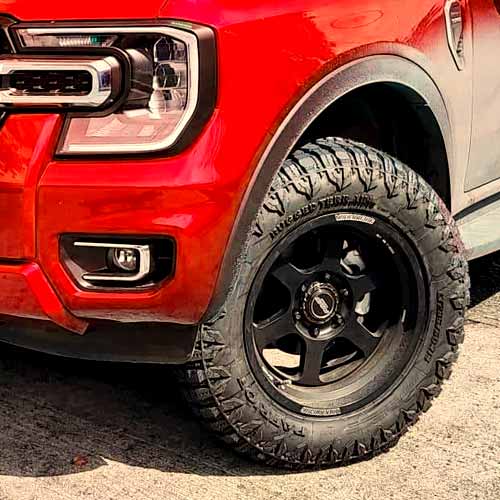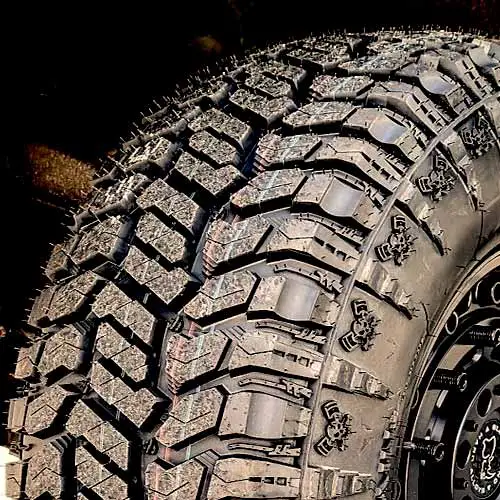Patriot RT Tires include both the RT and the RT+, where it stands for Rugged-Terrain. Such tires are also called hybrid and they sit right in the middle of all-terrain and mud-terrain tires. Both tires are very similar and the only different is in their sizes. Both comes with 3PMSF rating and are very cheap, well you can say budget friendly instead.

Being a tire engineer, in my opinion, both USA made Patriot RT tires offer a very unique design, which is very much capable of both on and off road. Where on highways the central ribs ensure stability while the outer tread blocks with minimal features provide great rubber contact patch. They are also great in snow are offer 3PMSF rating. But where these tires shine the most are rocky trails. They are simply great there as they offer everything there. But don’t expect these tires to last that long.
FYI, don’t confuse these tires with Radar Renegade RT, they are all the same (again the only difference is in their sizes).
Offered sizes
The Patriot RT offers you with 17 to 24 inches, while the RT+ variant gets to only have 16 to 24 inches.
Both tires offer speed ratings up to Q (where one sizes, LT265/60R20, also get to have S.
Learn more about speed ratings: https://tiredriver.com/speed-rating-on-tires/
If I talk about load ratings, they are offered in XL, E, and F, while the Plus version is also available in D.
Tread depth on these tires vary a lot where they range between 15 to 20/32″.
Also note that none of the sizes get any kind of warranty.
Tread Features
Patriot RT and RT+ both have similar looking tread which resembles the Goodyear MTR a lot (in a way). Let’s start things off from the middle.

Here the tread blocks run in a group of 3s, where the central block gets rapped with other two.
With this the tire enhances rubber contact with the road (as central area has the most pressure on it), and it also makes lateral groove which connects the wide outer circumferential channels.
And although it may not be visible here, all these central ribs have reinforced foundations.
On the outer channels there are also triangular shaped stone ejectors.
Moving towards the shoulders, here the blocks although seem to have been divided, they are not, as they are joined together from underneath.
Towards the inner edges, these blocks have stepped edges (ramps you can say), along with offset sides for vigorous biting, while towards outside, the tire features staggered shoulder lugs and a dual sidewall design.
Where on one side, there are plain shaped lugs (scroll to the top of the page to see), while the other has skulls engraved on it, designed for off road biting.
Noise
Being a tire engineer/designer, tread noise is always an issue where I end up scratching my head, as there as just so many variable involved here,
There is groove resonance which depends on the tire’s composition, there’s pitch sequencing, which differs with block sizes, there’s rolling noise, groove geometry, belt vibrations, the list is endless, so let me save you some trouble considering these tires at least
The Patriot RT tires are quite acoustics as they don’t provide better sound dampening. This is because the sound waves for one have a large area (from sides) to come in and second, these waves strike the walls of the tread and provide a lot of sound waves.
So, these tires are going to be noisy, even by mud terrain tire’s standards.
Wet Performance
Water is a non compressible liquid, so the only way to grip here is by removing it. And that removal is dependent on two main things, sipes, and hydroplaning. Let’s talk them both.
Wet Grip
The wet grip of a tire is highly dependent on the amount of siping it shows up (along with design as well), so the more the better.
Here the overall composition is also significant, as they give sipes flexibility to wipe off water.
The Patriot RT offers a very spongy rubber which soaks up the water pretty nicely, and so compared to other RT options, it’s overall performance is going to hold up.
Hydroplaning
Hydroplaning resistance is the tire’s ability to clear water off from its grooves swiftly, so it would not float on it, that’s why float speeds determine the tire’s resistance to hydroplaning/aquaplaning.
For Your Info: Float speed is just the maximum speed with which the tire can run on standing water without losing floating and losing traction.
With X and Z shaped grooves the rib makes in the middle which joins the outer circumferential channels, enough pathways are created for water to leave off quickly.
So overall, Nitto Ridge Grappler provides satisfactory hydroplaning resistance values.
Highway Performance
Being a rugged terrain tires, there aren’t too many expectation in terms of street performance, as these tires usually have to compromise on responsiveness, and grip so that they can perform off road.
Let’s judge it’s on road factors on by one.
Handling Response
Compared to other RTs, I think overall you are going to enjoy the tire’s overall feedback on smooth roads. It’s above average no doubt. I mean sure, you feel these tires a lot on corners, but they don’t understeer as much.
Actually this makes sense because these tires aren’t that heavy. Their light weight cap plies provide softer composition, so the tire is able to provide direct steering while a very small lag.
Lateral Stability
Both lateral traction and stability of the tire depends on the sides (of the tread). Why? Because when the tire rolls on corners, all of the weight is dependent on it’s sides.
With a ton of biters on shoulders, and minimal tread features, the Patriot RT offers a significant traction here overall.
This is because the tire makes a decent rubber contact while cornering with it’s elongated lugs, while the stepped edges (towards middle side) provides this tire with biters which converts in to lateral g forces.
Same is the case with dry grip as well.
Dry Grip
Dry grip has a lot to do with the tire’s middle area, as that makes the most contact with the surface (talking about directional traction here).
The Patriot RT and RT+, both provide you with 3 rib design here which are interconnected with each other with reinforced rubber underneath.
These blocks are more closed up together, and have minimal tread features, and both of these contribute in enhancing the tire’s grip.
So overall, it’s dry performance is exceptionally satisfactory, comparing to other hybrid tires out there.
Durability
The Patriot RT has a 10 ply rating, which is strong enough.
The tire offers 3 ply polyester casing as the core on which 2 wide steel belts run.
And above these steel belts there are 2 cap plies of nylon.
Still the tire gets to be very lighting weight as it’s cap plies are light weighted.
Snow Performance
Winter terrains have a lot of variations, there is ice, deep snow, hard packed snow, light snow…etc.
With rugged tires, the performance is often judged on both on road and off road snow, and the Patrot RT provides you with decent traction earning the 3 peak mountain snowflake, despite having a lot of siping like a winter tire.
For Your Info: The 3pmsf rating is just an acceleration test which tells you that the tire is better performing on (snowy roads) compared to all season tires.
The Patiot RT (and RT+) basically offer very wild shoulder lugs which cover most of the area of the tread. These provide scooping and at the same time with their offset edges and ramps on corners, offer biters to grip on hard snow.
The siping is less but they are full depth and also aids the process here.
Personally the tire surprises on deeper snow going up to 5 inches in depth, where it provides you with big spoons with serrated shoulders and sidewalls.
While the stone ejectors (triangular shaped engraved in thread voids), along with lateral gaps between the central tread blocks hold on to the snow to make a decent snow to snow contact.
Tread Wear
Patirot RT tires are not going to impress in the wear department, despite them going up to 20/32″ in tread depth.
Usually more tread depth means more time to wear, but Patriot RT with it’s spongy composition and a heavier internal construction burn out faster.
Mud
On mud, staying in hybrids offers top mud traction values, well compared to All terrain at least.
And here the Patriot RT is very good.
The tire lugs actually are designed like paddles, so if you consider the tread (in the image above), you’d see that there is a clear pathway for the mud to move sideways.
The tire is also not too sharp on sides, so it digs less and moves more, which is what makes a good mud tire.
Rocks
On rocks these tires stick from all sides, as they give a mixture of vertical and horizontal traction with it’s lugs. Let me explain how.
The central lugs of the tire (consider the image above in the tread section), are interconnected with each other, and so the grooves there act as biters, as they open and close to eat the rocky surface vertically.
While the staggered shoulders and side lugs with aggressive design ensures that the tire does not slip sideways.
With multiple stone ejectors like on shoulders and in between grooves, the tire also provides amazing speeds on gravely roads, (similar design is also seen on BF Goodrich KO2).
Sand
Sand is not easy. It requires some skills but things aren’t too difficult with such as soft tire as the Patriot RT.
It’s softer lugs provide ample footprint on this soft terrain and airing down the tire (which you always do), makes things better further.
The tire’s cool sidewall biters of dual design expand and make section width wider, and the tire is able to crawl through efficiently.
Though keep in mind, these tires don’t offer powerful bead protection, so I would not recommend running them with very low pressures, as the rim can fall off.
Things to keep in mind
The Patriot RT and RT+ and the same as Renegade RT and RT+, and the only differences is in their sizes, they did this for marketing reasons.
Nonetheless, the tire is still underrated given it’s performance.
It’s 3PMSF rating and it’s performance on deep snow is simply epic. The tire is also pretty well optimized for on road use, where although noise is an issue, these tires do great in rest of the sections.
But know with snowy performance, the tire’s rubber has to be kept softer, so this also causes tread wear issues a little bit as well.